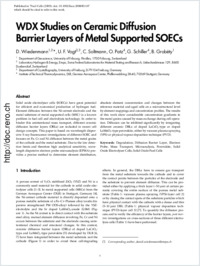WDX studies on ceramic diffusion barrier layers of metal supported SOECs
- Wiedenmann, Daniel Department of Geoscience, University of Fribourg, Switzerland - Laboratory Hydrogen & Energy, Empa, Swiss Federal Laboratories for Material Testing and Research, Duebendorf, Switzerland
- Vogt, U. F. Laboratory Hydrogen & Energy, Empa, Swiss Federal Laboratories for Material Testing and Research, Duebendorf, Switzerland - Department of Crystallography, University of Freiburg, Germany
- Soltmann, C. Institute of Technical Thermodynamics, DLR, German Aerospace Center, Stuttgart, Germany
- Patz, O. Institute of Technical Thermodynamics, DLR, German Aerospace Center, Stuttgart, Germany
- Schiller, G. Institute of Technical Thermodynamics, DLR, German Aerospace Center, Stuttgart, Germany
- Grobéty, Bernard Department of Geoscience, University of Fribourg, Switzerland
-
18.08.2009
Published in:
- Fuel Cells. - 2009, vol. 9, no. 6, p. 861-866
degradation
diffusion barrier layer
electron probe
mass transport
microanalysis
perovskite
solid oxide electrolyser cells
solid oxide fuel cells
English
Solid oxide electrolyser cells (SOECs) have great potential for efficient and economical production of hydrogen fuel. Element diffusion between the Ni-cermet electrode and the metal substrate of metal supported cells (MSC) is a known problem in fuel cell and electrolysis technology. In order to hinder this unintentional mass transport, different ceramic diffusion barrier layers (DBLs) are included in recent cell design concepts. This paper is based on wavelength dispersive X-ray fluorescence investigations of different SOEC and focuses on Fe, Cr and Ni diffusion between the metal grains of the cathode and the metal substrate. Due to the low detection limits and therefore high analytical sensitivity, wavelength dispersive electron probe microanalysis (EPMA) provides a precise method to determine element distribution, absolute element concentration and changes between the reference material and aged cells on a microstructural level by element mappings and concentration profiles. The results of this work show considerable concentration gradients in the metal grains caused by mass exchange during cell operation. Diffusion can be inhibited significantly by integrating different ceramic DBLs of doped LaCrO₃-type or doped LaMnO₃-type perovskite, either by vacuum plasma spraying (VPS) or physical vapour deposition technique (PVD).
- Faculty
- Faculté des sciences et de médecine
- Department
- Département de Géosciences
- Language
-
- English
- Classification
- Mineralogy
- License
- License undefined
- Identifiers
-
- RERO DOC 12628
- DOI 10.1002/fuce.200800118
- Persistent URL
- https://folia.unifr.ch/unifr/documents/301234
Statistics
Document views: 102
File downloads:
- grobety_wsc.pdf: 182
